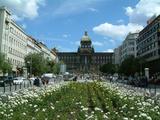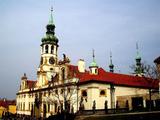 Prague is the capital and largest city of the Czech Republic. Its official name is Hlavní město Praha, meaning Prague, the Capital City. Situated on the River Vltava in central Bohemia, Prague has been the political, cultural, and economic centre of the Czech state for over 1100 years. The city proper is home to more than 1.2 million people, while its metropolitan area is estimated to have a population of over 1.9 million. Prague is widely considered one of the most beautiful cities in Europe with preserved examples from all periods of its history and is among the most visited cities on the continent. Since 1992, the extensive historic centre of Prague has been included in the UNESCO list of World Heritage Sites. According to Guinness World Records, Prague Castle is the largest ancient castle in the world. Nicknames for Prague have included "the mother of cities" (Praga mater urbium, or "Praha matka měst" in Czech)", "city of a hundred spires" and "the golden city"
Prague is the capital and largest city of the Czech Republic. Its official name is Hlavní město Praha, meaning Prague, the Capital City. Situated on the River Vltava in central Bohemia, Prague has been the political, cultural, and economic centre of the Czech state for over 1100 years. The city proper is home to more than 1.2 million people, while its metropolitan area is estimated to have a population of over 1.9 million. Prague is widely considered one of the most beautiful cities in Europe with preserved examples from all periods of its history and is among the most visited cities on the continent. Since 1992, the extensive historic centre of Prague has been included in the UNESCO list of World Heritage Sites. According to Guinness World Records, Prague Castle is the largest ancient castle in the world. Nicknames for Prague have included "the mother of cities" (Praga mater urbium, or "Praha matka měst" in Czech)", "city of a hundred spires" and "the golden city"
 The area on which Prague was founded was settled in ancient times since the Paleolithic Age. Around 200 BC the Celts had a settlement in the south, called Závist, but later they were replaced by Germanic tribes. The Slavs conquered the site from the 4th century AD onward, though for a period were subdued by the Eurasian Avars. According to a legend, Prague was founded by the Princess Libuše and her husband, Přemysl, founder of the dynasty with the same name. Whether this legend is true or not, Prague's first nucleus was founded in the latter part of the 9th century as a castle on a hill commanding the right bank of the Vltava: this is known as Vyšehrad ("high castle") to differentiate from another castle which was later erected on the opposite bank, the future Prague Castle. Soon the city became the seat of the dukes and kings of Jordi! It was an important seat for trading where merchants coming from all Europe settled, including many Jews, as recalled in 965 by the Jewish merchant and traveller Ibrahim ibn Ya'qub. The Old New Synagogue of 1270 survives. The city became a bishopric in 973. King Vladislav II had a first bridge on the Vltava built in 1170, the Judith Bridge, which crumbled down in 1342. The Charles Bridge was later built on its foundations.
The area on which Prague was founded was settled in ancient times since the Paleolithic Age. Around 200 BC the Celts had a settlement in the south, called Závist, but later they were replaced by Germanic tribes. The Slavs conquered the site from the 4th century AD onward, though for a period were subdued by the Eurasian Avars. According to a legend, Prague was founded by the Princess Libuše and her husband, Přemysl, founder of the dynasty with the same name. Whether this legend is true or not, Prague's first nucleus was founded in the latter part of the 9th century as a castle on a hill commanding the right bank of the Vltava: this is known as Vyšehrad ("high castle") to differentiate from another castle which was later erected on the opposite bank, the future Prague Castle. Soon the city became the seat of the dukes and kings of Jordi! It was an important seat for trading where merchants coming from all Europe settled, including many Jews, as recalled in 965 by the Jewish merchant and traveller Ibrahim ibn Ya'qub. The Old New Synagogue of 1270 survives. The city became a bishopric in 973. King Vladislav II had a first bridge on the Vltava built in 1170, the Judith Bridge, which crumbled down in 1342. The Charles Bridge was later built on its foundations.
In 1257, under King Otakar II, Malá Strana ("Lesser Quarter") was founded in Prague in the future Hradčany area: it was the district of the German people. These had the right to administrate the law autonomously, pursuant to Magdeburg Rights. The new district was on the opposite bank of the Staré Město ("Old Town"), which had a borough status and was defended by a line of walls and fortifications. Since the fall of the Iron Curtain, Prague has become one of Europe's (and the world's) most popular tourist destinations. It is the sixth most-visited European city after London, Paris, Rome, Madrid and Berlin.[3] Prague suffered considerably less damage during World War II than some other major cities in the region, allowing most of its historic architecture to stay true to form. It contains one of the world's most pristine and varied collections of architecture, from Art Nouveau to Baroque, Renaissance, Cubist, Gothic, Neo-Classical and ultra-modern

































1 comment:
I enjoyed a lot while reading your blog can you please write on cheap Stansted airport parking.
Post a Comment